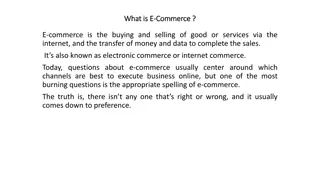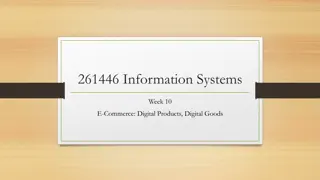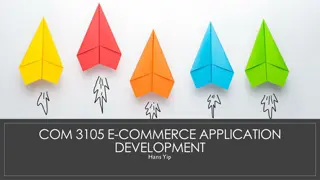Evolution of Commerce Education in India
Commerce education in India has a rich history dating back to the 19th century when vocational courses in typing and bookkeeping were introduced. Over time, it evolved to provide liberal business education and specific skill programs at different education levels. Today, commerce education in India continues to play a crucial role in preparing individuals for successful careers in the business world.
Uploaded on Mar 14, 2025 | 5 Views
Download Presentation

Please find below an Image/Link to download the presentation.
The content on the website is provided AS IS for your information and personal use only. It may not be sold, licensed, or shared on other websites without obtaining consent from the author.If you encounter any issues during the download, it is possible that the publisher has removed the file from their server.
You are allowed to download the files provided on this website for personal or commercial use, subject to the condition that they are used lawfully. All files are the property of their respective owners.
The content on the website is provided AS IS for your information and personal use only. It may not be sold, licensed, or shared on other websites without obtaining consent from the author.
E N D
Presentation Transcript
Commerce Education Commerce Education Ani Vadakke Purayil M.Com, M.Ed. NET (Com),NET (Edu),SET Faculty Department of Teacher Education Kannur University Kannur, Kerala. anivpknr@gmail.com
Commerce Education As a branch of knowledge, Commerce imparts experience of business world at large in all its manifestations. It prepares its learners for personally fruitful and socially desirable careers in the field of business The role of education is changing very rapidly due to changes in society. Education is in great demand and technology is changing and so is curriculum. The subject of commerce is skill oriented and life centric in nature. Commerce curriculum is more relevant because business provides maximum employment opportunities; hence maximum exposure and emphasis must be given for skill acquisition in students
Chesseman (1904) defined Commerce Education As: "Commerce education is that form of instruction which both directly and indirectly prepare the business man for his calling." Fredrik G. Nichols defined Commerce Education As: "Commerce education is a type of training which, while playing its part in the achievement of the general aims of education of any given level, has for its primary objective the preparation of people to enter upon a business career, or having entered upon such a career, to render more efficient service therein and to advance from their present levels of employment to higher levels.
History of commerce education In order to define the objectives of commerce education, it may be important to go a little into its history. The origin of commerce education can be traced to the 19th century. It started with the teaching of skill based courses of typing and book keeping , to meet the emerging manpower requirements in these areas. With an increase in commercial activities and expansion of banking, insurance, transportation and other related services, the nature and scope of commerce education changed. From a vocational bias in the initial years, the focus changed to providing liberal business education. Some experts even gave different objectives for different stages or levels of education. Prof. Dasgupta (1959) used three different expressions to indicate business education , at three different levels. At the junior level (higher secondary stage), it was referred to as commercial education, covering specific skills programmes; at the first degree stage, the term used was commerce education , to cover general stream courses for preparing semi professionals and at post graduation level, it was termed as Professional Business Education , with the aim of preparing experts in specific areas. In other words, commerce education, at less than degree level was referred to as commercial education or vocational business education .
commerce education In India Introduction In India commerce education began in the year 1886 with the establishment of a commercial school in Madras by the Trustees of Pachiyappa's charities. The Madras Government by about the same time instituted examination in commerce. A school of commerce was established in Calicut in 1895 by the Government of India. Commerce classes started in Presidency College, Calcutta, in 1903 and later became the Government Commercial Institute. Between 1903 and 1912 commercial institutions came into existence in Bombay and Delhi providing for skill formation in typewriting, methods. Collegiate level education began with the establishment of the Syndenham College of Commerce and Economics in Bombay in 1913. short-hand and business
Objectives of Commerce Education To develop skills such as conceptual skills, technical skills and practical skills in the field of industry, commerce, management and accounting. To prepare a student for a career in business or to start a business enterprise of his/her own. To give each student enough opportunities to acquire relevant knowledge about business and economy. To familiarise students with current business processes and practices. To familiarise students with the behaviour of markets, products as well as finance. To develop skills in the use of information technology for business. To develop capability in each student to identify business opportunities, analyse their risk-return possibilities and support business development in socially desirable avenues with strong moral commitment To develop in students a business attitude and skills to be precise and articulate, considering its ethical side.
To provide knowledge of principles, practices, procedures, etc. about business, trade and industry and its relationship with the society; To provide basic knowledge of technological tools including computers and its application in business; To develop an understanding of the environment in which we live and undertake various activities relating to business; To develop basic skills needed to undertake different commerce related activities; To educate learners in different functional areas and develop their basic understanding about the same; To develop right aptitude and qualities for undertaking business and commerce related activities; and To encourage the spirit of entrepreneurship and prepare learners to enter into a business career.
IMPORTANCE OF COMMERCE EDUCATION Satisfy Increasing Human Wants Increase our Standard of Living Links Producers and Consumers Generates Employment Opportunities Increases National Income and Wealth Expansion of aids to Trade Growth of Industrial Development Encourages International Trade Helps During Emergencies
Features of Commerce Curriculum Following are the special features to be considered while transacting curriculum. Linkage with Industry Entrepreneurial Values ICT Enabled Practical skills commerce
Nature and Scope of Commerce. Commerce is considered to be a part of business. It is that activity of business which is concerned with the exchange of goods and services. Some persons feel that commerce and business are synonymous. The following characteristics will help in understanding the nature of commerce: I. Economic Activities: Economic activities are taken up with a motive to earn profits. Commerce deals with those activities which are undertaken for profit. So only economic activities are included in commerce. It is the motive which is important and not the activity. Some activity may both be economic and non-economic. A trader buys goods to sell them again and earn profit while a consumer buys goods for consumption. II. Exchange of goods and services: Commerce involves an exchange of goods and services for profit. The goods may be produced or procured from other sources. The purchase of goods should be to re-sell them. It means that goods should be purchased for trading purposes.
III. Earning Motive: The motive for undertaking trading activities is to earn profit. Profit is an incentive or reward for undertaking commercial activities. Any activity which does not have the incentive of profit will not be a part of commerce. If a trader gives some goods as charity then it will not be a part of commerce because profit motive is missing. But if the same trader sells goods to customers, it will form a part of commerce because profit motive is present. So earning motive must be present in activities or transactions. IV. Creation of Utility: Commerce creates place and time utility in goods. The goods may not be consumed at the place of production. These may be needed at different places. The goods are taken to those places where they are in need. Transportation facilities help in creating place utility in goods. The goods are also needed at different periods of time. It may not be possible to produce goods whenever they are demanded. The producers go on producing goods as per their capacity. V. Regularity of Transactions: The transactions should be regular. No isolated transaction will be a part of commerce. The sale of old furniture for replacing it by new is not a part of commerce. At the same time the sale of furniture by a furniture trader is commerce since the transactions are regular.
References Madegowda, J., "Commerce Education at Cross Roads", a paper presented at the II-State Level Conference held in Davangere in July 1997. Teaching of Commerce J.C. Aggarwal, Vikas publication, New Delhi Teaching of Commerce, Seema Rao, Anmol prakashan, New Delhi http://books.google.co.in/books?id=jIYaD4JMp5c C&pg=PA1&source=gbs_toc_r&cad=4#v=onepage& q&f=false Y.K.Singh book : Teaching of Commerce























